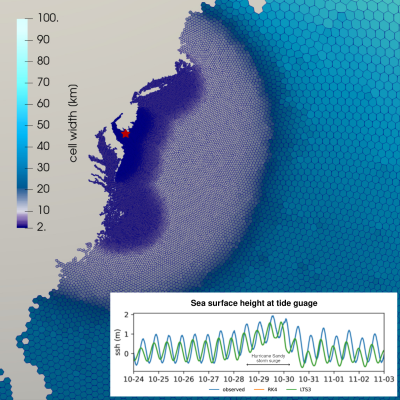Faster Storm Surge Modeling with Local Time-Stepping
Partitioning the globe into a mesh consisting of cells of different sizes based on the level of accuracy desired in a given region is useful for many applications of modern ocean models. The largest step forward in time an ocean model can take is governed by the size of the smallest cell in the mesh. To increase the efficiency of the time-stepping process, researchers can use a local time-stepping (LTS) method that uses multiple time-steps based on the size of cells in a region. By using a particular LTS method, researchers found that they can run certain models up to 35% faster than without LTS while producing comparable results.
This work presents the first practical application of LTS in the Model for Prediction Across Scales-Ocean (MPAS-Ocean). Specifically, it uses LTS to model the storm surge caused by Hurricane Sandy. This work shows that LTS schemes are viable for solving real-world problems in MPAS-Ocean. Using LTS, researchers can use meshes with very high resolution in certain regions without sacrificing computational performance. For example, this enables efficient, high-resolution models for coastal applications where coastlines need to be highly resolved without sacrificing model accuracy.
Partitioning the globe into cells of different sizes, depending on the level of accuracy desired in a specific region, is useful for many applications of modern ocean models. Regions where more accuracy is needed use smaller cells, with larger cells elsewhere to save on computational costs. These types of partitions are generally called variable-resolution meshes. A well-known limitation of explicit time-stepping methods, used to advance the state of the model in time, is that the largest step forward the model can take is limited by the size of the smallest cell in the mesh. LTS methods allow researchers to select multiple time-steps based on the size of cells in a localized region. Researchers used LTS schemes to model the storm surge around the East Coast of the U.S. during Hurricane Sandy in 2012. They showed that, in the best cases, an LTS scheme is up to 35% faster at producing sea-surface height predictions of comparable quality to those produced by a state-of-the-art global time-stepping method. This work helps inform the requirements of efficient mesh design for LTS. For LTS to be efficient on a given mesh, enough cells must use the large time-step relative to those that use the small time-step, typically a ratio of at least 1:5.

